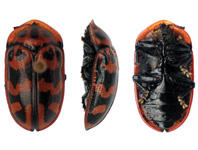Abstract
Deois (Deois) mourei Cavichioli & Sakakibara (Hemiptera: Cercopidae) is recorded for the first time from Argentina and Paraguay. The eggs and immature stages of the species are described and illustrated; the main characters that distinguish instars are body size, color, number of flagellomeres, and number of tibial and metatarsomere spines. A key for identification of nymphs of D. (D.) mourei and a key to differentiate nymphs of the sympatric species D. (D.) mourei and Notozulia entreriana Berg are provided. In addition, a list of host plants of D. (D.) mourei in Argentina is given.
References
Box, H.E. (1929) Una relación de nuestros conocimientos de la familia Cercopidae en la Argentina. Revista Industrial y Agrícola de Tucumán, 20 (1–2), 1–18.
Carvalho, G.S. & Webb, M.D. (2005) Cercopid Spittlebugs of the New World (Hemiptera, Auchenorrhyncha, Cercopidae). Pensoft, Sofia, 271 pp.
Cavichioli, R.R. (1987) Sobre a biologia de Kanaima fluvialis (Lallemand, 1924) (Homoptera, Cercopidae). Revista Brasileira de Entomologia, 31 (1), 71–82.
Cavichioli, R.R. (1988) Estudo sobre a morfologia de Kanaima fluvialis (Lallemand, 1924) (Homoptera, Cercopidae). Revista Brasilera de Entomologia, 32 (3/4), 393–410.
Cavichioli, R.R. & Sakakibara, A.M. (1993) Deois Fennah, Descrição de uma espécie nova e notas taxonômicas (Homoptera, Cercopidae, Tomaspidinae). Revista Brasileira de Zoologia, 10 (4), 747–750.
http://dx.doi.org/10.1590/S0101-81751993000400019Fennah, R.G. (1949) New genera and species of Neotropical Cercopoidea (Homoptera). Annals and Magazine of Natural History, 12 (1), 605–620.
Fennah, R.G. (1953) Revisionary notes on Neotropical Monecphorine Cercopoidea (Homoptera). Annals and Magazine of Natural History, 12 (6), 337–360.
http://dx.doi.org/10.1080/00222935308654431Ferreira da Costa, A.C. & Sakakibara, A.M. (2002) Reestruturação do gênero Deois Fennah, desrição de um novo genero e de novas especies (Homoptera, Cercopidae, Tomaspidinae). Revista Brasileira de Entomologia, 46, 195–207.
http://dx.doi.org/10.1590/S0085-56262002000200012Fewkes, D.W. (1969) The biology of sugar cane froghoppers. In: Williams, J.R., Metcalfe, J.R., Mongomery, R.W. & Mathes, R. (Eds.), Pests of Sugar Cane. Elsevier, Amsterdam, pp. 283–307
Foieri, A., Marino de Remes Lenicov, A.M. & Virla, E.G. (2016) Descriptions of the immature stages and new host plant records of Notozulia entreriana (Berg) (Hemiptera: Cercopidae) pests of grasses in subtropical areas of the Americas. Zootaxa, 4103 (1), 54–62.
http://dx.doi.org/10.11646/zootaxa.4103.1.5Foieri, A., Virla, G.E. & Marino De Remes Lenicov, A.M. (2015) New host plants records for the froghopper Notozulia entreriana (Hemiptera: Cercopidae) with new data on its occurrence in diverse ecological zones in Argentina. Revista de la Sociedad Entomologica Argentina, 74 (1–2), 79–84.
Guagliumi, P. (1957) Contribuciones al estudio de la candelilla de las gramíneas en Venezuela. III. Cuadro de distribución geográfica de las especies de Aeneolamia Fennah y sus plantas hospederas señaladas en Venezuela. Agronomia Tropical, 6, 165–194.
Heinrichs, E.A. & Barrion, A.T. (2004) Rice-feeding Insects and Selected Natural Enemies in West Africa. Biology, Ecology, Identification. International Rice Research Institute, Los Banos &WARDA, The Africa Rice Center, Abidjan, 242 pp.
Holmann, F. & Peck, D.C. (2002) Economic damage of grassland spittlebugs (Homoptera: Cercopidae) in Colombia: A first approximation of impact on animal production in Brachiaria decumbens pastures. Neotropical Entomology, 31, 275–284.
http://dx.doi.org/10.1590/S1519-566X2002000200016Lapointe, S. & Sonoda, R.M. (2001) The effect of arthropods, disease, and nematodes on tropical pastures. In: Sotomayor-Rios, A. & Pitman, W.D. (Eds.), Tropical Forage Plants: Development and use. CRC Press, Boca Raton, pp. 201–218.
Leite, L.G., Machado, L.A., Goulart, R.M., Tavares, F.M. & Filho, A.B. (2005) Screening of entomopathogenic nematodes (Nemata: Rhabditida) and the efficiency of Heterorhabditis sp. against the sugarcane root spittlebug Mahanarva fimbriolata (Fabr.) (Hemiptera: Cercopidae). Neotropical Entomology, 34, 785–790.
http://dx.doi.org/10.1590/S1519-566X2005000500010Liang, A.-P. & Fletcher, M. (2002) Morphology of the antennal sensilla in four Australian spittlebug species (Hemiptera: Cercopidae) with implications for phylogeny. Australian Journal of Entomology, 41, 39–44.
http://dx.doi.org/10.1046/j.1440-6055.2002.00266.xMacedo, N., Botelho, P.S.M. & Campos, M.B.S. (2003) Controle químico da cigarrinha-da-raíz em cana-de-açúcar e impacto sobre as populações de artrópodes. STAB. Açúcar, Álcool e Subprodutos, Piracicaba, 21, 30–33.
Morrone, J.J. (2006) Biogeographic areas and transition zones of Latin America and the Caribbean Islands based on panbiogeographic and cladistic analyses of the entomofauna. Annual Review of Entomology, 51, 467–494.
http://dx.doi.org/10.1146/annurev.ento.50.071803.130447Peck, C.D. (2002) Distribucion y reconocimiento del salivazo de los pastos en la Costa Caribe de Colombia. Pasturas Tropicales, 24 (1), 4–15.
Pires, C.S.S., Sujii, E.R., Fontes, E.M.G., Tauber, C.A. & Tauber, M.J. (2000) Dry-season dormancy in eggs of Deois flavopicta (Homoptera: Cercopidae): roles of temperature and moisture in nature. Environmental Entomology, 29, 714–720.
http://dx.doi.org/10.1603/0046-225X-29.4.714Rodman, D.H. & Miller, D.J. (1992) Enzyme activities associated with salivary glands of the froghopper Eoscarta carnifex (F.) (Homoptera, Cercopidae): possible role of salivary catalase in phytotoxicity. Australian Journal of Zoology, 40, 365–370.
http://dx.doi.org/10.1071/ZO9920365Rzedowski, G. & Rzedowski, J. (2004) Manual de malezas de la región de Salvatierra, Guanajuato. Flora del Bajío y de Regiones Adyacentes. Fascículo complementario XX. Instituto de Ecología, Pátzcuaro, 315 pp.
Sakakibara, A.M. (1979) Sobre algumas espécies brasileiras de Deois Fennah, 1948 (Homoptera, Cercopidae). Revista Brasileira de Biologia, 39 (1), 9–30.
Sanz, N.T. (1997) Checklist of Pests and Diseases of Selected Crops of Belize. Belize National Plant Protection Service, Ministry of Agriculture and Fisheries, Central Farm, Cayo District, 151 pp.
Souza, A.R.R. & Nilakhe, S.S. (1985) Damage evaluation and chemical control of spittlebugs in rice crops. Anais da Sociedade Entomológica do Brasil, 14, 177–188.
Thompson, V. (2004) Associative nitrogen fixation, C4 photosynthesis, and the evolution of spittlebugs (Hemiptera: Cercopidae) as major pests of Neotropical sugarcane and forage grasses. Bulletin of Entomological Research, 94 (1), 189–200.
http://dx.doi.org/10.1079/ber2004293

